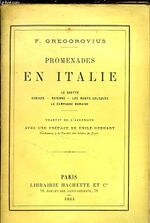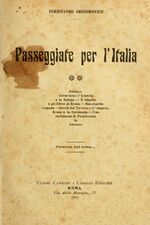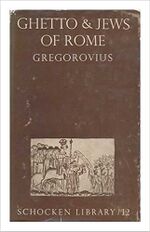Difference between revisions of "File:1856 Gregorovius.jpg"
| Line 3: | Line 3: | ||
[[File:1948 Gregorovius en.jpg|thumb|150px|English ed. (1948)]] | [[File:1948 Gregorovius en.jpg|thumb|150px|English ed. (1948)]] | ||
{de} [[Ferdinand Gregorovius]] <1821-1891>. '''''Der Ghetto und die Juden in Rom''''' | {de} [[Ferdinand Gregorovius]] <1821-1891>. '''''Der Ghetto und die Juden in Rom'''''. In ''Wanderjahre in Italien: Figuren, Geschichte, leben und Szenerie aus Italien''. Köln [Germany]: Agrippina-Verlag, 1853. | ||
== Other German editions == | == Other German editions == | ||
Revision as of 14:45, 5 March 2022
{de} Ferdinand Gregorovius <1821-1891>. Der Ghetto und die Juden in Rom. In Wanderjahre in Italien: Figuren, Geschichte, leben und Szenerie aus Italien. Köln [Germany]: Agrippina-Verlag, 1853.
Other German editions
- Der Ghetto und die Juden in Rom, ed. Leo Baeck. Berlin [Germany]: Schocken, 1935.
- Der Ghetto und die Juden in Rom: Klagegesang der Kinder Juda in Rom. Bremerhaven [Germany]: Kniess, 1986.
Translations
- {fr} Le ghetto. In Promenades en Italie. Préface de Émile Gebhart. Paris [France]: Librairie Hachette, 1894 <1853>
- {it} Il ghetto e gli ebrei di Roma. In Passeggiate per l'Italia. Vol.2: [Roma e Lazio], tr. Mario Corsi. Roma: Ulisse Carboni, 1907 <1853>.
- {en} The Ghetto and the Jews of Rome, ed. Moses Hadas. New York: Schocken Books, 1948 <1853>.
Abstract
"A century ago the great German historian Ferdinand Gregorovius settled in Rome to work on his epochal study of postclassical Rome. There he came to know the miserable little community of Jews that had lived in the eternal city without interruption for two millenniums ... For clarity and conciseness this essay is a classic ... The prose account summarizes the varying intensity of the hardships perennially endured by the Jews in Rome ... Segregation, the yellow badge, exclusion from trades, and compulsory attendance at conversionist sermons were only finally abolished by Pious IX in 1848 ... The author's poetic "Lament of the Children of Israel in Rome" discloses his capacity for empathy and his deep pity and admiration for the people he came to know in the days of their emancipation."-- Review by J. Coert Rylaarsdam, The Journal of Religion 26.4 (Oct. 1949).
File history
Click on a date/time to view the file as it appeared at that time.
| Date/Time | Thumbnail | Dimensions | User | Comment | |
|---|---|---|---|---|---|
| current | 15:03, 5 March 2022 |  | 510 × 800 (53 KB) | Gabriele Boccaccini (talk | contribs) |
You cannot overwrite this file.
File usage
The following 4 pages use this file:


